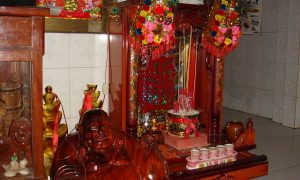It has been a long-term concern for many researchers and practitioners in the development sector that the basic rights of social minorities in Cambodia have been suppressed in the contemporary development process. The Cambodian government’s growth-oriented policies have become more radical and outspoken since the emergence of China as its most prominent development partner. The Lower Sesan II (LSS2) hydro dam project demonstrates the most recent example of this dynamic that enables us to see how things are developing in the country.
The LSS2 hydro dam project has had a negative impact on the cultural rights of the Bunong Indigenous communities in Steung Treng province, Cambodia.
In spite of growing consumption, Cambodia is among those Southeast Asian countries with the lowest electrification level. But it has faced rapidly growing energy demand over recent years. In 2019, demand reached 2,000 megawatts. To meet demand, the Cambodian government has prioritised hydropower, which China has been financing among other large scale projects as part of its massive Belt and Road Initiative. The $816 million Lower Sesan 2 hydropower project had been developed as a part of much wider energy development initiatives.
Located on the Sesan River in Sesan District, Stung Treng Province, north-eastern Cambodia, LSS2 is the largest dam project in Cambodia. It was developed and operated by the Hydro Power Lower Sesan 2 Company Limited, a joint venture between Cambodia’s Royal Group, Vietnamese EVN International Joint Stock Company and China’s Huaneng Hydrolancang International Energy. China’s Huaneng Hydrolancang International Energy is a subsidiary of one of the top five Chinese state-owned power generation companies. The dam is a 33,560-hectare reservoir with a generating capacity of 400 megawatts.
The development of this dam, however, required more than 5,000 people in six villages, most of whom are indigenous, to be relocated and resettled. These people are traditionally dependent on rice cultivation, forest products and fisheries. Since the commencement of LSS2’s construction in 2013, several nonviolent resistant protests, regarded as acts causing political turmoil by authorities, were organised in opposition to the project and tension intensified from 2014-2017. Protesters were detained and summonsed by the Steng Treng Provincial Court. So far there have been legal complaints and pressure against three villagers who speaks on behalf of the affected Bunong families. The closure of a health centre and the dismissal of state teachers were used to pressure affected villagers to relocate. About 800 families who belong to various hill communities from four villages near the Srepok and Sesan Rivers in Stung Treng province have reluctantly accepted the resettlement compensation while the remaining 53 families from Kbal Romeas community have declined the resettlement offer from the company and decided to remain in their ancestral communities.
These resistant families have suffered a lot. They escaped the flooding of villages but lived in tears of pain and poverty on their ancestral land close to inundated villages. Since 2020, they have faced a new wave of conflict because the government has granted an economic land concession to rubber company Siev Guek Investment, for development of the land on which the Kbal Romeas community lives.
Lack of consultation and communication
Clearing for the dam’s reservoir preparation and construction work on water diversion channels started in 2013 and 2014 respectively. The LSS2 dam project blocked both the Sesan and Srepok rivers- two of the largest rivers in the Mekong River Basin. The consequences are serious social, economic and cultural impacts. However, there was a lack of active, meaningful consultation and decision making in the LSS2 project, which did not meet the required minimum standard of public participation. Very few affected communities both upstream and downstream were engaged in consultation; none were engaged in decision making processes.
In 2008, only three consultations were conducted for the study of the environmental impact assessment (EIA). Hundreds of people from Stung Treng and Ratanakiri provinces were invited to join the first consultative meeting while only local officials were invited to join the second one. For the third consultative meeting, few affected communities were invited to join representatives from relevant provincial departments, ministries and NGOs. Furthermore, the relevant information on the project has not been widely disseminated to affected communities.
The 2008 EIA report itself failed to present a review of electricity supply alternatives; adequate information about mitigation costs; a contractual framework for allocating costs, risks, revenues, and responsibilities among relevant parties; a regulatory framework to protect the rights of citizens; or evidence that the project owners and government authorities have the capacity to develop the Lower Sesan 2 dam without significant damage to countless people’s health, property, livelihoods, and economic future.
Peaceful protests were organised to express the community’s grave concern and frustration over LSS2 dam project’s lack of deep, meaningful consultation with affected families. Despite this, the Fisheries Administration of Cambodia in July 2021 issued a certificate recognising the outstanding fish protection performance of the dam company.
Insufficient resettlement compensation
The resettlement process offered by the company began in 2015–2016. Approximately 800 indigenous families, most of them belong to the Bunong ethnic group, reluctantly accepted the resettlement offer by the company while another roughly 53 families refused to accept the resettlement offer by the company. Instead, they moved to another piece of land which is part of their ancestral land and is close to the flooded villages. They decided not to accept resettlement because they wanted to remain on their ancestral land where they were born and raised, and to which they have a very strong spiritual and cultural connection. They prefer to die with their ancestors and forests although they have faced discrimination and are considered to be anti-government. “We do not want to leave our land where we inherited irreplaceable cultural heritage from our ancestors”.
According to a 2015 survey by Ley resettlement compensation should be an average of USD 108,126 for each household plus cost for a relocation ceremony, lost economic opportunity and burial and spiritual land in each community. Meanwhile, the relocated victim families have been promised compensation of five hectares of land and a pre-built home, or USD 6,000 to re-establish their livelihoods. So far, some families have not received the full resettlement compensation package as promised by the company while facing difficulties in adapting themselves to a different environment at the resettlement site, the new Kbal Romeas community.
Wider adverse cultural impact
The Bunong indigenous group is one of the most ancient inhabitants of the forest, with strong cultural and economic ties to the environment. Their culture has a significant role in bringing solutions to internal community conflict. Their rotational slash and burn cultivation tradition comprises several ritual practices which are culturally irreplaceable. Since LSS2 officially began operating in 2017, its negative impacts have been catastrophic and devastating to the Bunong ethnic community. They have faced a loss of cultural, religious and traditional identity and lifestyle as well as their livelihoods. The ancestral burial forest, and the spirit forest, where they conducted various different traditional practices, were completely inundated. These forests are sacred and the Bunong are closely connected to them. The affected Bunong are pained and speechless to witness the inundation of the guardian spirit of their village (naekta), the guardian spirit of the forest (araek), their ancestors’ graveyards and a Buddhist temple where they practice their mixture of belief in Theravada and animism. They were unable to hold any traditional ceremony, and they believe that failing to do will result in the ancestral spirits cursing or punishing them. Traditionally, the Bunong ethnic people have a closely knitted sense of belonging and a shared community. However, the controversial LSS2 has damaged the solidarity and unity amongst Bunong ethnic people who have accepted the resettlement offer and those who rejected it. Siblings and spouses were physically and emotionally separated based on whether or not they accepted the resettlement offer. It is obvious that the Bunong ethnic people are concerned that the younger generation will have no chance to learn and preserve their traditional, cultural practices. They are extremely concerned that their future prospects are threatened.
The harm to Bunong ethnic communities should neither be taken for granted nor be seen as the inevitable cost of the economic development expected from the LSS2 dam project. It must be taken seriously as a gross human rights violation. As a signatory of R2P adopted by the UN and as the first and the only country in ASEAN to nominate R2P as a national focal point, Cambodia has responsibility to protect its people, including its indigenous people, whose rights are guaranteed by international law and the government-ratified national legal framework. Rather than rebuffing criticisms that the LSS2 dam has negatively impacted on the Bunong indigenous community, the Cambodian government must recognise that harming the Bunong indigenous people could lead to further human right abuses.
Hydropower dams in Cambodia generate extensive processes of commodification and extraction, feeding the country’s vast shadow economy.
Rupture—hydropower dams in Cambodia as “engines of extraction”
What consequence might this project incur? It is likely to end up with the mid-term social impacts similar to the controversial ADB-funded railway rehabilitation project, which failed due to its negligence of not listening to the affected local communities’ voices and did not engage with them in meaningful, active, deep consultation and decision making.
Just and fair compensation over damage to livelihood, environment and culture based on an independent, participatory and people-centered assessment which integrates cultural, environmental and social impacts in its process must be provided to 53 affected families who rejected the Hydro Power Lower Sesan 2 Company’s resettlement offer and moved to higher ground on their ancestral land. Authorities at the national level and in Steng Treng province should provide them with social integration and community reconstruction support to restore their livelihoods and traditional cultural practices and conserve their heritage. Based on traditional knowledge and practices, official land registration must be facilitated to prevent the illegal encroachment and to fully protect land ownership. Best practice and lessons from the Akphiwat Meanchey resettlement experience in 1997-99 can be a good model to follow. This project involved resettlement processes which were participatory, respected the community’s voice and allowed sufficient time for planning and preparation.
 Facebook
Facebook  Twitter
Twitter  Soundcloud
Soundcloud  Youtube
Youtube  Rss
Rss 



